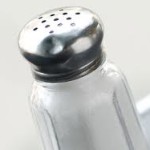
A recent report released from the Centers for Disease Control and Prevention (CDC) indicated that 9 in 10 or 90% of adults in the United States gets too much sodium (salt) in their diet every day.
According to the report, the main sources of sodium include many common foods from common restaurant or grocery store items, and in fact nearly all Americans consume much more sodium than they should.
The report was issued in the latest Vital Signs report from the CDC. In the report the findings indicated that 10 types of foods are responsible for more than 40 percent of people’s sodium intake. Most common sources on the high salt intake list are breads and rolls, luncheon meat such as deli ham or turkey, pizza, poultry, soups, cheeseburgers and other sandwiches, cheese, pasta dishes, meat dishes such as meat loaf, and snack foods such as potato chips, pretzels and popcorn.
The CDC further cautions that although some foods, such as bread, have a low sodium content in a single serving, because these items are typically consumed several times a day, they add up to a lot of sodium.
“Too much sodium raises blood pressure, which is a major risk factor for heart disease and stroke,” said CDC Director Thomas R. Frieden, M.D., M.P.H. “These diseases kill more than 800,000 Americans each year and contribute an estimated $273 billion in health care costs.”
While the U.S. Dietary Guidelines recommend limiting sodium intake to less than 2,300 milligrams per day, the recent CDC report indicates that the average person consumes about 3,300 milligrams of sodium. For older individuals, over the age of 51, the recommended salt intake in the diet is 1,500 milligrams per day. This means that individuals in this group are getting as much a twice the recommended amount of salt in their diets. The reduced sodium level of 1500 mg per day also applies to anyone with high blood pressure, diabetes, and chronic kidney disease, and African Americans the CDC mentions.
The following were some of the highlighted points made in the CDC Vital Signs Report:
•Ten types of foods account for 44 percent of dietary sodium consumed each day.
•65 percent of sodium comes from food sold in stores.
•25 percent of sodium comes from meals purchased in restaurants.
•Reducing the sodium content of the 10 leading sodium sources by 25 percent would lower total dietary sodium by more than 10 percent and could play a role in preventing up to an estimated 28,000 deaths per year.
Reducing daily sodium consumption is difficult since it is in so many of the foods we eat. People can lower their sodium intake by eating a diet rich in fresh or frozen fruits and vegetables without sauce, while limiting the amount of processed foods with added sodium. Individuals can also check grocery food labels and choose the products lowest in sodium. CDC supports recommendations for food manufacturers and restaurants to reduce the amount of sodium added to foods.
“We’re encouraged that some food manufacturers are already taking steps to reduce sodium,” said Dr. Frieden. “Kraft Foods has committed to an average 10 percent reduction of sodium in their products over a two year period, and dozens of companies have joined a national initiative to reduce sodium. The leading supplier of cheese for pizza, Leprino Foods, is actively working on providing customers and consumers with healthier options. We are confident that more manufacturers will do the same.”
To learn more about ways to reduce sodium, visit www.cdc.gov/salt.
![Herbal Reference Substances are Key to Everyday Products <!-- AddThis Sharing Buttons above -->
<div class="addthis_toolbox addthis_default_style " addthis:url='http://newstaar.com/herbal-reference-substances-are-key-to-everyday-products/3512112/' >
<a class="addthis_button_facebook_like" fb:like:layout="button_count"></a>
<a class="addthis_button_tweet"></a>
<a class="addthis_button_pinterest_pinit"></a>
<a class="addthis_counter addthis_pill_style"></a>
</div>When it comes to quality control testing and the development of new products, Botanical Reference Materials (BRMs), also known as Herbal References are critically important. To help companies ultimately obtain all-important FDA approval, the Food and Drug Administration provides in its guidance a recommendation that […]<!-- AddThis Sharing Buttons below -->
<div class="addthis_toolbox addthis_default_style addthis_32x32_style" addthis:url='http://newstaar.com/herbal-reference-substances-are-key-to-everyday-products/3512112/' >
<a class="addthis_button_preferred_1"></a>
<a class="addthis_button_preferred_2"></a>
<a class="addthis_button_preferred_3"></a>
<a class="addthis_button_preferred_4"></a>
<a class="addthis_button_compact"></a>
<a class="addthis_counter addthis_bubble_style"></a>
</div>](http://newstaar.com/wp-content/uploads/2021/02/Achillea_millefolium_flowers-100x100.jpg)
![Quality Electrochemical Biosensors are Critical for Medical, Food and Chemical Industry <!-- AddThis Sharing Buttons above -->
<div class="addthis_toolbox addthis_default_style " addthis:url='http://newstaar.com/quality-electrochemical-biosensors-are-critical-for-medical-food-and-chemical-industry/3512086/' >
<a class="addthis_button_facebook_like" fb:like:layout="button_count"></a>
<a class="addthis_button_tweet"></a>
<a class="addthis_button_pinterest_pinit"></a>
<a class="addthis_counter addthis_pill_style"></a>
</div>A number of industries have, at their core, a need to frequent or even continuous analysis of biological media. These include the medical and pharmaceutical fields, biotech firms, and food and chemical companies. To maintain quality standards and develop new products, these industries rely heavily […]<!-- AddThis Sharing Buttons below -->
<div class="addthis_toolbox addthis_default_style addthis_32x32_style" addthis:url='http://newstaar.com/quality-electrochemical-biosensors-are-critical-for-medical-food-and-chemical-industry/3512086/' >
<a class="addthis_button_preferred_1"></a>
<a class="addthis_button_preferred_2"></a>
<a class="addthis_button_preferred_3"></a>
<a class="addthis_button_preferred_4"></a>
<a class="addthis_button_compact"></a>
<a class="addthis_counter addthis_bubble_style"></a>
</div>](http://newstaar.com/wp-content/uploads/2020/10/Electrochemical-Biosensor-100x100.jpg)
![Company Develops Industrial Mixers Well-Suited for both Fragile and Explosive Products <!-- AddThis Sharing Buttons above -->
<div class="addthis_toolbox addthis_default_style " addthis:url='http://newstaar.com/company-develops-industrial-mixers-well-suited-for-both-fragile-and-explosive-products/3512071/' >
<a class="addthis_button_facebook_like" fb:like:layout="button_count"></a>
<a class="addthis_button_tweet"></a>
<a class="addthis_button_pinterest_pinit"></a>
<a class="addthis_counter addthis_pill_style"></a>
</div>Industrial drum mixers are normally applied to blend mixes of varying viscosities such as adhesive slurries or cement. Some of these mixers have the capability of blending mixes of very different particle sizes such as fruit and ice cream, and gravel and cement slurry. The […]<!-- AddThis Sharing Buttons below -->
<div class="addthis_toolbox addthis_default_style addthis_32x32_style" addthis:url='http://newstaar.com/company-develops-industrial-mixers-well-suited-for-both-fragile-and-explosive-products/3512071/' >
<a class="addthis_button_preferred_1"></a>
<a class="addthis_button_preferred_2"></a>
<a class="addthis_button_preferred_3"></a>
<a class="addthis_button_preferred_4"></a>
<a class="addthis_button_compact"></a>
<a class="addthis_counter addthis_bubble_style"></a>
</div>](http://newstaar.com/wp-content/uploads/2020/06/bandeau-sofragir2-100x100.jpg)